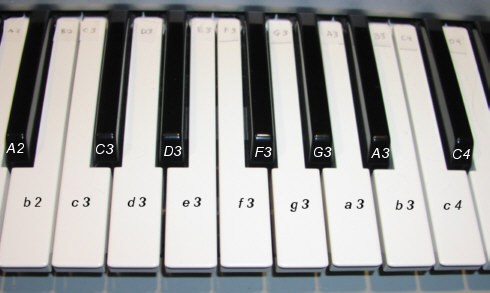 | ||
A keyboard tablature is a tablature for a keyboard instrument such as the piano. The most common keyboard tablature is written using letters and numbers that designate the timing and keys to hit on a keyboard or piano.
Contents
Modern piano tablature is based on scientific pitch notation, a variation of letter notation which has roots going back to the XI century when Italian Guido of Arezzo developed Solfege.
Piano tab notation
An example of modern piano tab notation, the scale of F played on 2 octaves:
3|--------c-d-e-f-| 2|f-g-a-A---------| 2|--------c-d-e-f-| 1|f-g-a-A---------|Some of the rules for this keyboard tablature are:
Another example of piano tab notation, the chords E, F, and G:
E F G 3|---|-c-|-d-| 2|-b-|-a-|-b-| 2|-G-|-f-|-g-| 2|-e-|---|---|Periodic system
Another keyboard tablature (though less frequently seen) is based on a periodic system of numbers, like most modern tablatures, although incorporating negative and positive numbers assigned to the clefs (as positive for the treble clef and negative for the bass clef). This particular method uses the middle C as the reference point. Unlike many tab forms the keyboard tab has far different placement values, meaning, regardless of the arrangement of the numbers it can still have the same value, but is displayed differently.
Visual example
12 12 12 12 12 12 12 12 07 07 07 07 09 09 09 09 04 04 04 04 04 04 04 04 0 0 0 0 0 0 0 0 -12 -8 -7 -5 -3 -3 -3 P-----------X P-----------X(a basic C, Am/C, progression)
How to compile
The numbers are projected and arranged by value. The particular number is placed in the corresponding column; however, columns are "pushed upward" when notating chords. This "column" system is not affective of the tab itself, more so the appearance, thus it is basically irrelevant.
